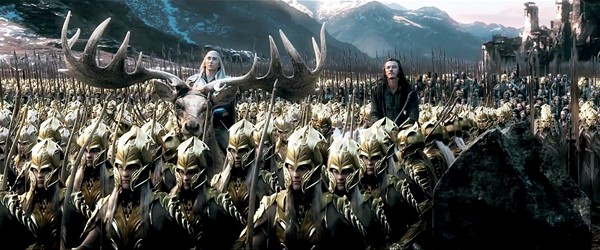There’s The Hobbit that is, and The Hobbit that might have been. Let’s talk about the latter first.
Far back in the mists of time (read: the mid-1990s), Peter Jackson and his screenwriter/producer/significant other Fran Walsh wanted to do a film trilogy based on the work of
J. R. R. Tolkien. Their original plan logically started with The Hobbit and condensed the events of the three Lord of the Rings novels into the remaining two films. But getting the fantasy movies financed was an uphill battle, so they cut costs by excising the “short” prequel of The Hobbit and pitching only the two darker and more action-packed Lord of the Rings movies. But when an exec at New Line finally saw the light, he wanted three movies, all based on The Lord of the Rings. Jackson agreed and made history with his now-classic fantasy trilogy, which culminated with 2003’s Return of the King winning 11 Academy Awards.
Naturally, New Line wanted more and set about an epic quest to bring The Hobbit to the screen and thus earn another dragon’s hoard’s worth of gold. They partnered with MGM, who then promptly went bankrupt, to make two movies out of the book that established Middle Earth. Jackson, Walsh, and screenwriter Philippa Boyens were back, and they brought in Guillermo del Toro (Pan’s Labyrinth, Pacific Rim) to direct. The actual book Tolkien wrote is much lighter in tone than The Lord of the Rings books and is the shortest of the four volumes. But the chance to make a single, tight adaptation of The Hobbit had passed, and so Boyens and company brought in some material from Tolkien’s notes, short stories, and appendices to flesh out the story. But after years of delay, del Toro reluctantly moved on, and a recaptialized MGM demanded three movies to ensure steady cash flow as it emerged from bankruptcy. Professor Tolkien’s pastoral fantasy about dwarves who loved to sing, dragons who loved gold, and a pathologically honest hobbit burglar was now budgeted just shy of half a billion dollars.

The Battle of the Five Armies
Which brings us to The Hobbit that is. Boyens and Jackson worked from the two-movie plan they had developed with del Toro to expand the material even further and, with 2012’s The Unexpected Journey and 2013’s The Desolation of Smaug, have now crafted three financially successful films. But were they artistically successful?
The short answer is no; the long answer is yes with a but. There are shots, scenes, and whole sequences of The Battle of the Five Armies that are as riveting and beautiful as anything in Jackson’s oeuvre. When the elf Legolas (Orlando Bloom) tries to cross a bridge made from a fallen, crumbling tower while dwarven king Thorin Oakenshield (Richard Armitage) fights the orc champion Azog at the top of a frozen waterfall, it is a virtuoso display of action movie choreography worthy of Raiders of the Lost Ark. Martin Freeman does an excellent job of holding down the trilogy’s center as Bilbo Baggins, and Armitage brings a stately, tragic air to Thorin, the penniless dwarf who risked it all to reconquer his rightful throne as King under the Mountain from the dragon Smaug, only to lose his soul in the process.
As a work of epic fantasy to be binge-watched on HD flatscreens over a weekend, The Hobbit will hold its own against Game of Thrones, provided you’re not just in it for the HBO series’ extensive nudity. But as a filmgoing experience in its own right, The Battle of the Five Armies is erratic and unsatisfying. The opening sequence, where Bard the Bowman (Luke Evans) confronts the dragon Smaug (voiced by Benedict Cumberbatch) as Laketown burns around him should be edge-of-your-seat thrilling. But even a dyed-in-the-wool fanboy like me, who first read The Hobbit when my age was still counted in single digits, had trouble working out who was who and why I should care until the old guard of Cate Blanchett’s Galadriel, Ian McKellan’s Gandalf, and Christopher Lee’s Saruman slip on their Rings of Power and mix it up with Sauron on the top of a mountain. But even that incredible scene isn’t part of Tolkien’s book, and it’s the plague of additional subplots that keeps the entire trilogy from achieving greatness. There’s a great movie buried in the almost eight hours of The Hobbit trilogy, and I’m sure Jackson, Walsh, and Boyens, know it. But as the dwarf Balin (Ken Stott) says, “Don’t underestimate the evil of gold.”